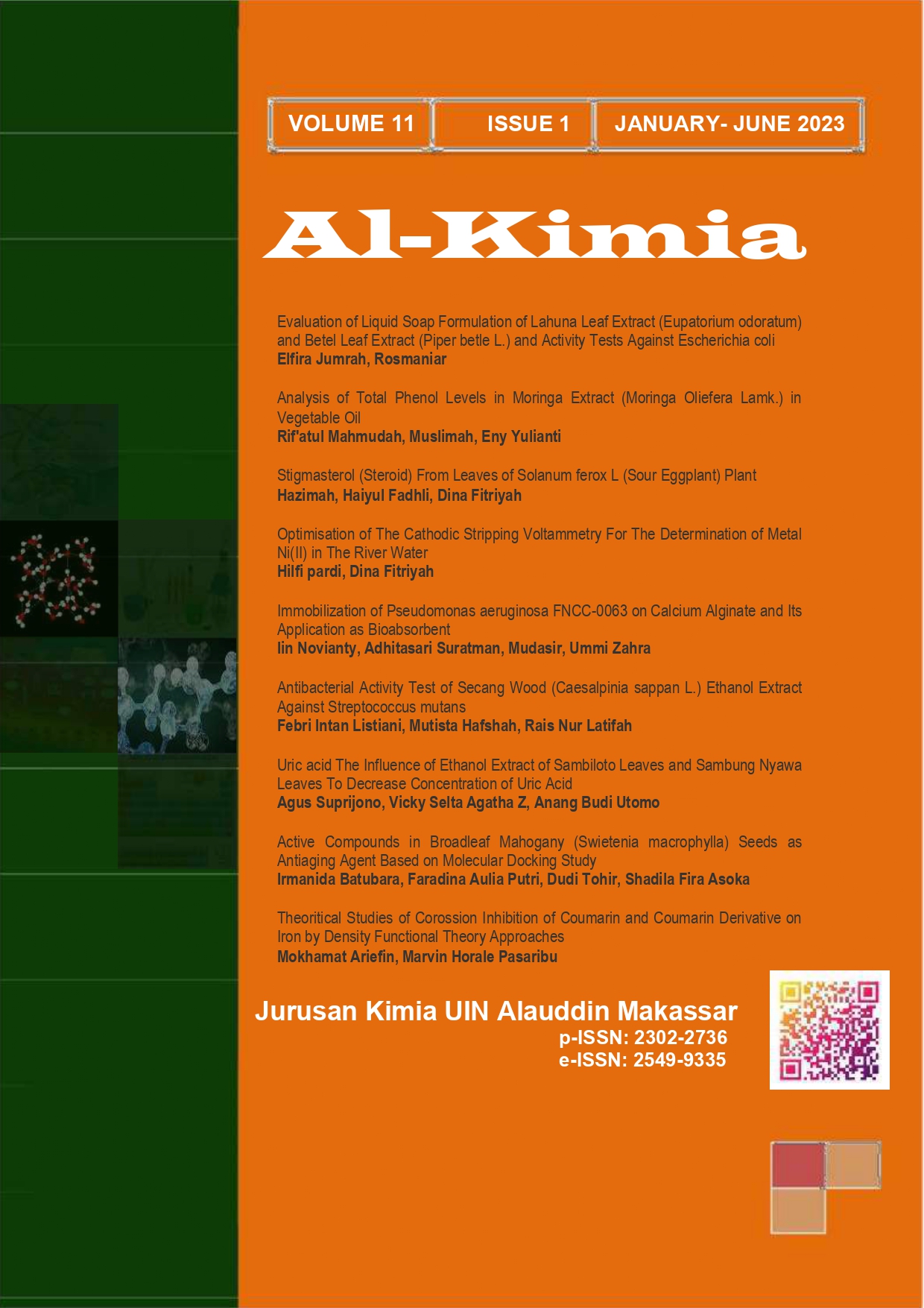The Antibacterial Activity Testing on Acetyleugenol Against Staphylococcus aereus
Abstract
The main contents of clove oil are phenolic compounds, namely eugenol, eugenol acetate and gallic acid, as well as flavonoids. One of the derivatives of the eugenol compound is acetyl eugenol which was developed by the esterification reaction between eugenol and acetic acid anhydride using the sonochemical method. Synthesis of acetyleugenol was sonicated for 30 minutes at a temperature of 70-80°C. The % yield of the synthesized compound is calculated and continued with testing which includes solubility, melting point, FTIR and GC-MS tests, which are then tested for antimicrobial activity. The research results show that eugenol and acetic acid anhydride compounds with a NaOH catalyst can be synthesized using ultrasonic waves and produce a % yield of 3.50%. The resulting synthesis can melt starting at a temperature of 30°C and can dissolve in ethanol, methanol, chloroform and ether but does not dissolve in distilled water. FTIR testing on the acetyl eugenol compound showed the presence of -OH phenolic groups, C=C alkenes, C=C aromatics, C-O esters, and C=O esters. Acetyleugenol at concentrations of 1.25%, 2.5%, 5%, and 10% was able to act antibacterial on Staphylococcus aureus cultures with a density of 1.0 X 108 CFU/mL.
Downloads
References
C. Duri Kartika Et Al., “Pengaruh Gugus Metoksi Pada Senyawa 4- Metoksibenzaldehida Terhadap Sintesis Senyawa N’- (4-Metoksibenzilidene)-4-Hidroksibenzohidrazida Dengan Metode Iradiasi Gelombang Mikro,” 經濟研究, vol. 16, no. 1994, pp. 1–37, 2015, [Online]. Available: http://eprints.ums.ac.id/37501/6/BAB II.pdf.
Dan W. S. R. Rosanti Suryani Tince Mbatu, 2I Putu Bayu Kenanda, I Gede Yeyen Suharta, “Aktivitas Minyak Atsiri Daun Cengkeh Sebagai Antijamur Terhadap Candida albicans,” J. Media Sains, vol. 2, no. 1, pp. 61–65, 2018, [Online]. Available: http://jurnal.undhirabali.ac.id/index.php/mp3/article/view/360/326.
Dinurrosifa, R.S dan Indriyanti, E. A Green Synthesis Of Acetyl Eugenol By Sonochemical Method and Potential As Anti Inflammatory In-Vitro. Jurnal Kimia dan Pendidikan Kimia (JKPK), 7(3): 324-332.
H. Carrasco A. et al., “Eugenol and its synthetic analogues inhibit cell growth of human cancer cells (Part I),” J. Braz. Chem. Soc., vol. 19, no. 3, pp. 543–548, 2008, doi: 10.1590/S0103-50532008000300024.
J. B. Buil, J. Zoll, P. E. Verweij, W. J. G. Melchers, and A. M. C. Bergmans, Mycology. 2017.
J. Towaha, “Manfaat Eugenol Cengkeh dalam Berbagai Industri Di Indonesia,” Perspektif, vol. 11, no. 2, pp. 79–90, 2012.
L. E. García Reyes, “Kimia Organik,” J. Chem. Inf. Model., vol. 53, no. 9, pp. 1689–1699, 2013.
P. D. Panuluh, “Potensi Cengkeh (Syzigium Aromaticum) sebagai Antibakteri Methicillin Resistant Staphylococcus Aureus (MRSA),” J. Ilm. Kesehat. Sandi Husada, vol. 10, no. 2, pp. 270–274, 2019, doi: 10.35816/jiskh.v10i2.168.
R. Bulan, “Reaksi Asetilasi Eugenol dan Oksidasi Metil Iso Eugenol,” J. Eugenol, pp. 1–8, 2004.
S. Lahlou, L. F. L. Interaminense, P. J. C. Magalhães, J. H. Leal-Cardoso, and G. P. Duarte, “Cardiovascular Effects of Eugenol, A Phenolic Compound Present in Many Plant Essential Oils, in Normotensive Rats,” J. Cardiovasc. Pharmacol., vol. 43, no. 2, pp. 250–257, 2004, doi: 10.1097/00005344-200402000-00013.
T. Ernawati, A. Budiana, and T. Ernawati, “Bioaktivitas Turunan Metil Sinamat Terhadap Pertumbuhan Bakteri Escherichia coli, Staphylococcus aureus, Bacillus subtilis, Pseudomonas aureugenosa dan Jamur Candida albicans,” J. Kim. Val., vol. 1, no. 1, pp. 60–64, 2016, doi: 10.15408/jkv.v0i0.3154.
W. Widayat, B. Cahyono, and N. Ngadiwiyana, “Rancang Bangun Dan Uji Alat Proses Peningkatan Minyak Cengkeh Pada Klaster Minyak Atsiri Kabupaten Batang,” J. Ilmu Lingkung., vol. 10, no. 2, p. 64, 2012, doi: 10.14710/jil.10.2.64-69.
Y. D. Safitri and N. E. D. Purnamawati, “Perbandingan Aktivitas Antibakteri Ekstrak Methanol Gagang dan Bunga Cengkeh (Syzygium Aromaticum) terhadap Bakteri Staphylococcus aureus ATCC 25923,” J. Sains dan Kesehat., vol. 3, no. 3, pp. 410–416, 2021, doi: 10.25026/jsk.v3i3.354.
Yance Manopo, H. J. Sohilait, and H. Kainama, “Isolasi Eugenol Dari Bunga Cengkeh Dan Sintesis Eugenil Asetat (2-Methoxy-4-(2-Propen-1-YL)-Phenyl Acetate),” MJoCE, vol. 1, no. 1, pp. 54–63, 2011.
Authors who publish with this journal agree to the following terms:
1) Authors retain copyright and grant the journal right of first publication with the work simultaneously licensed under a Creative Commons Attribution License that allows others to share the work with an acknowledgement of the work's authorship and initial publication in this journal.
2) Authors are able to enter into separate, additional contractual arrangements for the non-exclusive distribution of the journal's published version of the work (e.g., post it to an institutional repository or publish it in a book), with an acknowledgement of its initial publication in this journal.
3)Authors are permitted and encouraged to post their work online (e.g., in institutional repositories or on their website) prior to and during the submission process, as it can lead to productive exchanges, as well as earlier and greater citation of published work (See The Effect of Open Access).


